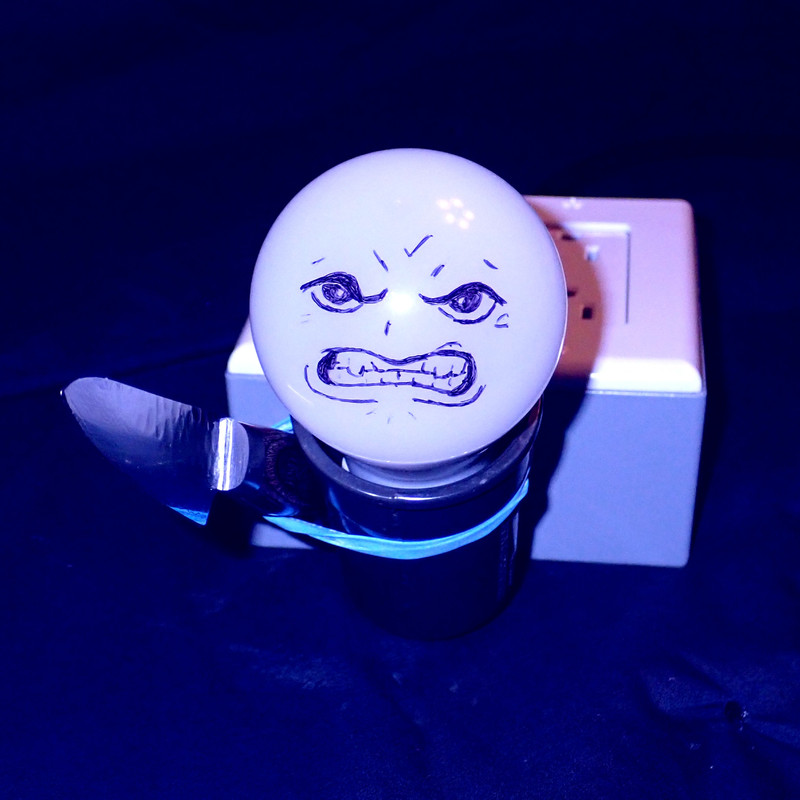Yes, it’s a spicy title. Yes, I plan to back it with what I consider very reasonable evidence of the claims, in the form of a lot of research papers. I would simply ask that you read to the end before deciding I’ve lost it.
The last decade, or perhaps 15 years, has involved a huge set of changes in how humans interact with technology, and, in particular, with how we light. For all but the last few decades of human history, lighting involved incandescence: Glowing things. Fire, candles, lanterns, and even older light bulbs are all incandescent sources. Florescent lighting has been around for a bit, first in commercial spaces, and then in homes. But, in the last decade, the shift has been to LED lighting in everything - light bulbs, phones, TVs, computer monitors, even e-ink readers. They’re cheap and efficient. What we haven’t really asked is, “How do they impact humans?”
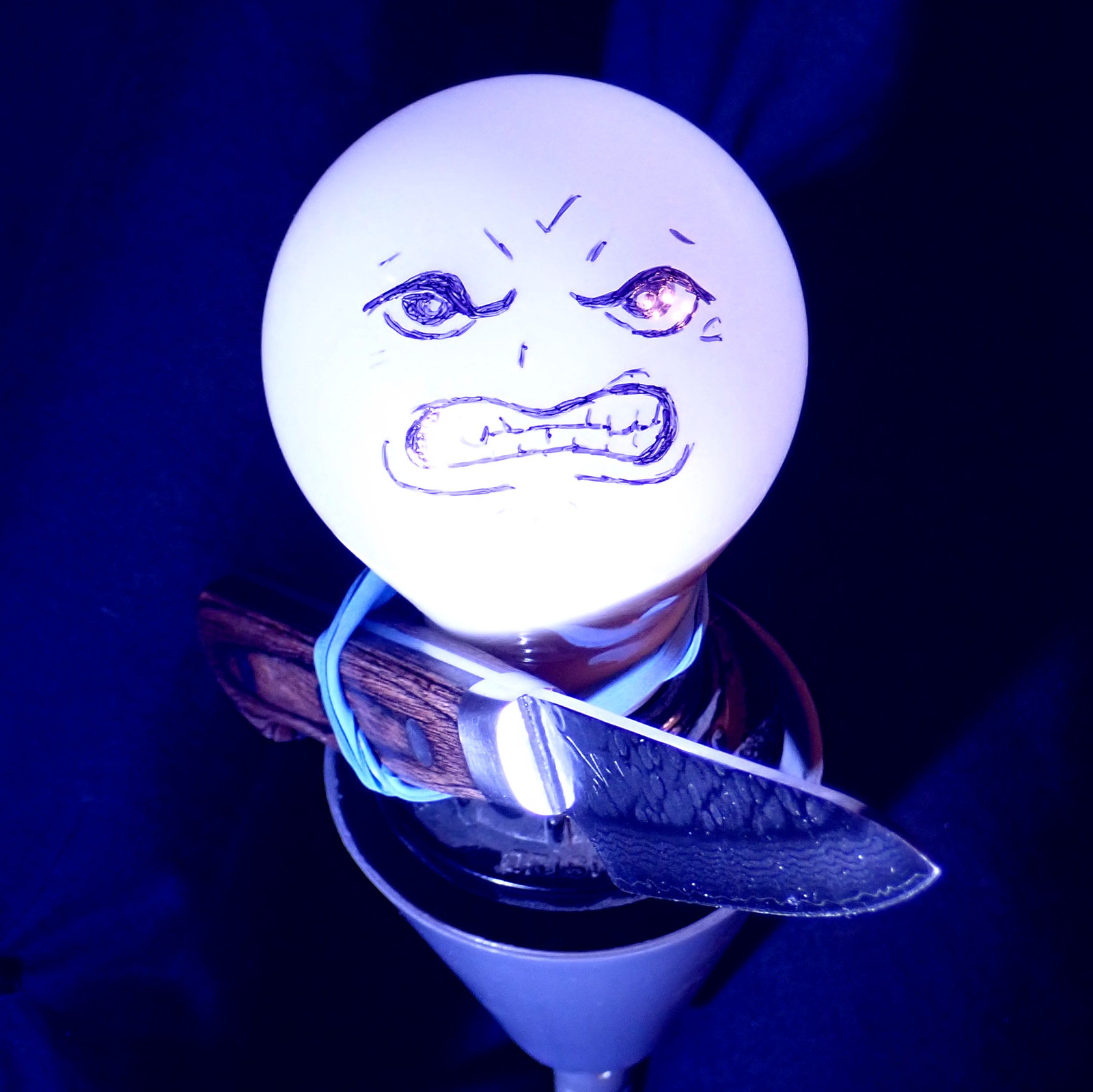
And the answer may horrify you. It sure did me. The summary is simple enough: LED lighting badly suppresses human melatonin production at night, which impacts sleep quality. Poor sleep quality has all sorts of nasty effects on human health - but it’s worse. Melatonin is also involved in the suppression of tumors and cancers. If your melatonin levels are low at night (from disruption or from simple night shift work), your risk of various cancers goes up by somewhere in the 30-80% range, depending on the cancer and study. The International Agency for Research on Cancer (IARC), back in 2007, considered “shift work” to be a “probable human carcinogen,” and plenty of other studies have demonstrated the link as well. Lighting, especially in the evenings and nights, is quite literally deadly serious. And we’ve gone about utterly screwing it up in the pursuit of “efficiency.”

Human Centered Technology
One of the things that’s been bothering me lately is that we’ve lost the connection between our technology suites and humans, with the end result that the technology we use seems more and more driven by the needs and capabilities of the technology. We develop something, and the question is “How can we best use the strengths of this?” or (more commonly) “How can we best profit from this?” - instead of “How can this best support human health and happiness?” One can point to a wide range of areas in which profit or simply “The technology is good at this so we’ll use it for this!” has taken precedence over actual human results.
The smartphone and social media, in particular, are regularly shown to have horrible impacts on humans, but our approach has been to collectively assume they’re just inevitable, and to see about filing off some of the rough edges, instead of recognizing that they are built, as they are, by people, for purposes that are (often) rather at odds with actual human health and happiness (in particular, the stock price of the public corporations that produce and distribute these products - yes, humans respond very well to incentives).
The question with lighting shouldn’t be a simple “Is this or that technology more efficient at producing light?” - though that’s an interesting and certainly useful metric. The question should be, “Does this lighting technology support human health and function?” In 2023, now that we’ve put LEDs in everything, the answer, once the sun goes down, seems a blindingly clear “No!” Throughout the studies I’ve been digging into, there’s a lot of hemming and hawing about “Well, yes, blue light from LEDs is nasty to humans, but we can’t question the 24/7 productivity that lighting offers, so… I suppose we might file off some edges with future research…” - without ever asking the questions about “Is 24/7 productivity actually good for humans?”
Do we exist to serve the needs of our technology, or does our technology exist to serve the needs of humans? It’s an important question!
How Do White LEDs Work?
White LED bulbs. They’re everywhere. But do you know they actually work? They’re internally blue LEDs with a phosphor coating that shifts some of the energy from blue over to the rest of the spectrum - the reds, yellows, and greens. For most white LEDs, the blue light peaks around 450-480nm. Remember this range, it’s important later. You can see this characteristic “white LED spectrum” exhibited on one of my less-well-behaved flood bulbs. My spectrometer grating loses efficiency over in the reds past 600nm, and I’ve not compensated for that, but you can see the blue LED light leaking through the phosphor coating, and the rest of the light coming from the phosphor spread. If you’ve ever wondered why white LED bulbs seem to fade gradually when you cut the power to them instead of just turning off instantly, this is why - the phosphor coating takes a bit of time to finish emitting.
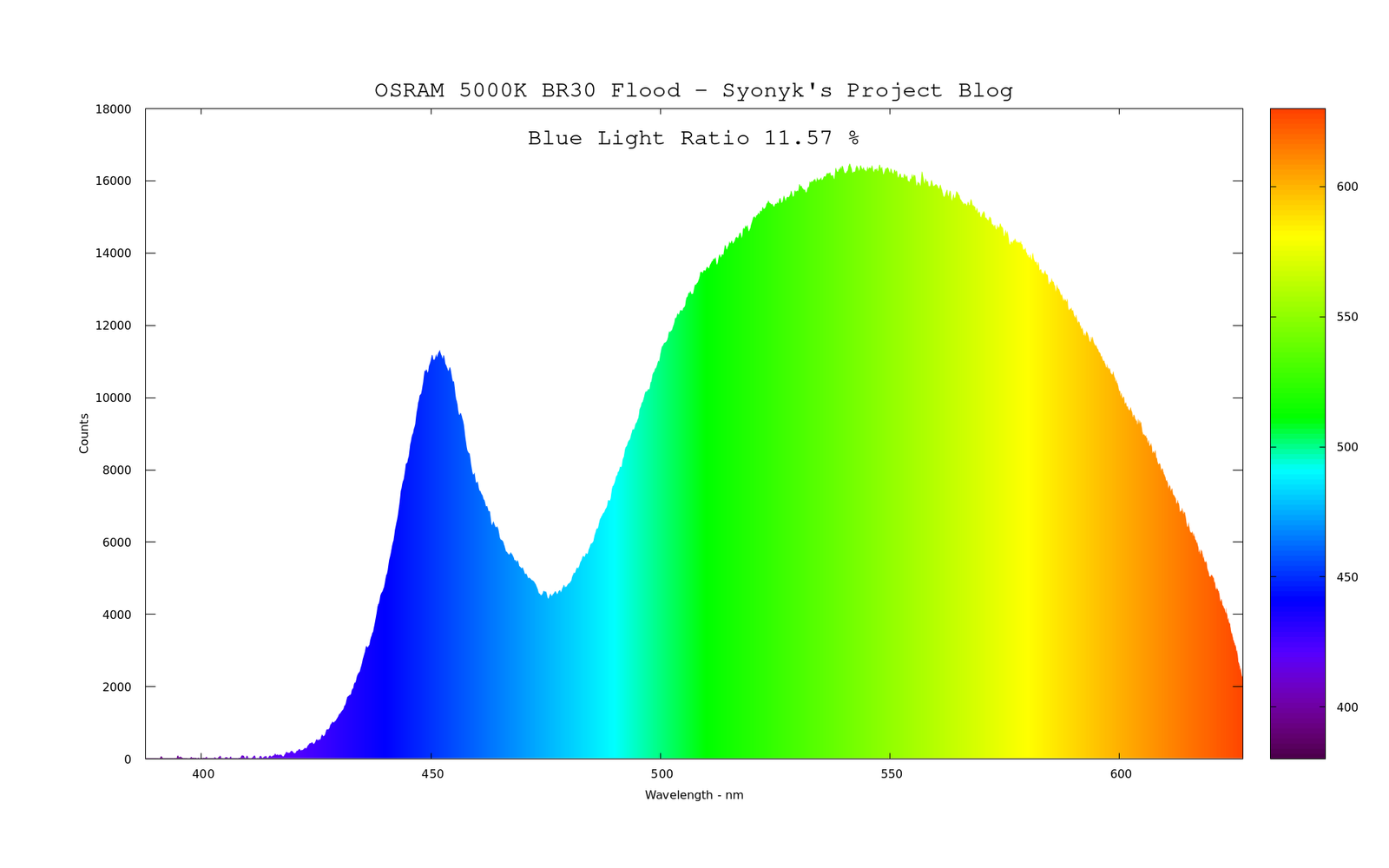
Every commercial white LED you’ll find on the market works on this principle. You can find LED lights that are separate R/G/B emitters (a lot of the color changing “smart bulbs” operate in this mode), but if you’ve ever used one, the light from them, while visibly white, isn’t quite right. They look white to the eye, but they’re actually three separate peaks of light, and they don’t do a very good job rendering colors. This is why some of the small LED packages are RGBW - they include a white LED in addition to the red/green/blue ones, to improve color rendering if you want to just light a space flexibly.
Oh, and how do white LEDs age? The phosphor coating bleaches out with time and use. This means that more blue is emitted than out of the factory from older bulbs. In some cases, the bulbs aren’t very old. There’s been a lot of digital ink spilled lately about purple street lights, and they’re simply what white LEDs look like without the phosphor working properly. I’ve actually got some failed LED phosphor in my office lighting strips - so much for “warm white.”

Spectrum, Color Temperature, and Blue
One of the reasons this problem has gone rather under the radar is because human eyes don’t see spectrum directly - we see the average color of a light source. If you go to a hardware store, you’ll almost certainly see a demo of light color temperatures in the bulb aisle (typically around 2700K for “warm” light, around 5000K for “cool” light). You can get to those average light warmths a wide range of ways, though, and so two different bulbs with the same color temperature may have very different spectrum plots to get to the same visible end result. Without running them through a spectrometer, you can’t tell the difference - our eyes simply don’t work like that.

Although, in general, a “warmer” bulb is likely to have a lot less blue in it than a “daylight” bulb, it’s no guarantee. And, funnily enough, nobody seems to bother putting spectrums on light bulb packages. Probably because it’s horrifying if you know what you’re looking at. It’s also safe to assume that I’m going to be doing exactly that in some upcoming posts.
Blue and Melatonin Suppression
Now for the biology: The human eye has more than just the rods and cones. It has, discovered about 20 years ago (!), some additional cells that serve the rather specific purpose of detecting blue light. They’re known by the mouthful “Intrinsically-Photoreceptive Retinal Ganglion Cells”, or ipRGCs for short. These cells aren’t part of the visual system - they’re part of the circadian regulation system, and they work entirely independently of the rods and cones. Many people who are completely blind can still sense blue light (some report a sense of “bright” when in blue light that they don’t sense with other colors), and these receptors function as the “time synchronizer” for the human circadian rhythm. Left completely isolated from natural light sources, the human body will typically run something a bit longer than 24h, but the regular presence of day/night cycles serves to correct this and sync it up to our 24 hour solar day. Assuming, of course, we don’t screw that up.
Melatonin is an important hormone in humans (and a lot of other animals) that serves to regulate the day/night cycle. It’s what makes you sleepy at night, and as I’ll talk about later, it’s been linked to a lot of other health impacts if it’s suppressed. On purely natural light cycles, the blue in daylight causes the ipRGCs to send a signal that suppresses production of it - hence our natural “awake during the day” pattern. After the sun goes down, this suppression stops, and levels build up until we go to sleep, peaking in the early morning hours. Or, at least, they’re supposed to… unless we screw with them.
One of the papers that really dug into how various flavors of “white light” impacts humans is “Circadian Potency Spectrum with Extended Exposure to Polychromatic White LED Light under Workplace Conditions”. They tested a sample of people under a wide range of “white” lights, with various different spectrum distributions. Previous testing on this had mostly focused on single frequencies of light, but this test worked with a range of ways of generating something we’d describe as “white light.”

This study also monitored participants for far longer than previous testing - full overnight “staying up in the light” shifts. They tested melatonin levels throughout the night, and remember, what you want for good sleep and general health is high melatonin levels during the night. Not low! Line “F” is good. Line “A” (which looks like a standard white LED spectrum…) is bad. There’s a lot of noise in the results, but it’s clear that the spectrum of the light has a major impact in overnight melatonin levels.
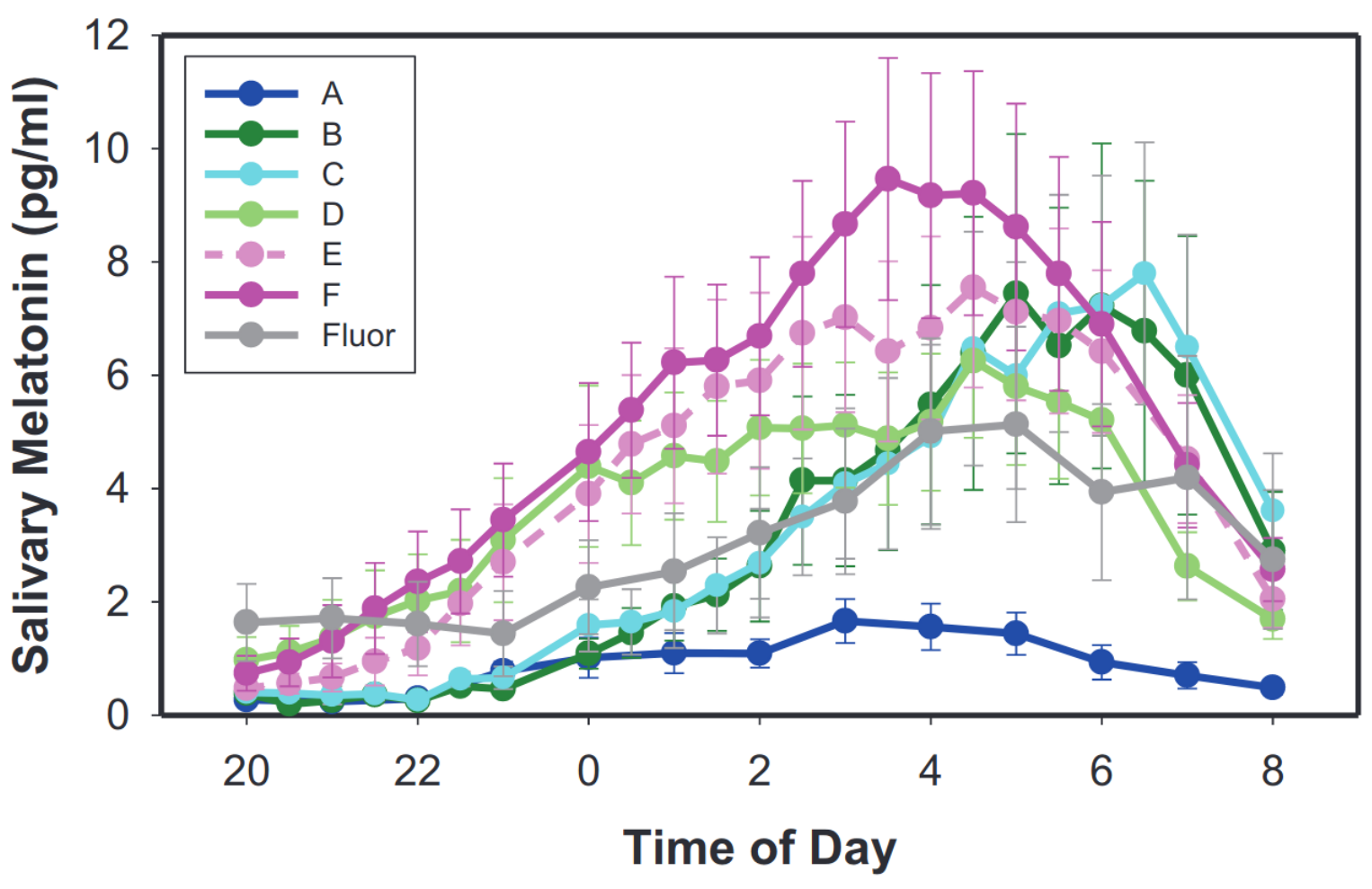
Crunching the data, they came up with the following sensitivity curve for melatonin suppression - a peak around 477nm, with the 50% sensitivity level from 438-493nm. This is entirely consistent with all the other results I’ve seen, just in somewhat more detail. This is empirical data from the entire human visual and circadian system, so “end to end” results. Some other tests have poked with various pieces in isolation and ended up with slightly different ranges, but weren’t able to compensate for things like how the human retina is somewhat yellow and absorbs some blue. This peak also corresponds to the “clear blue sky” peak in normal daylight, amazingly enough!
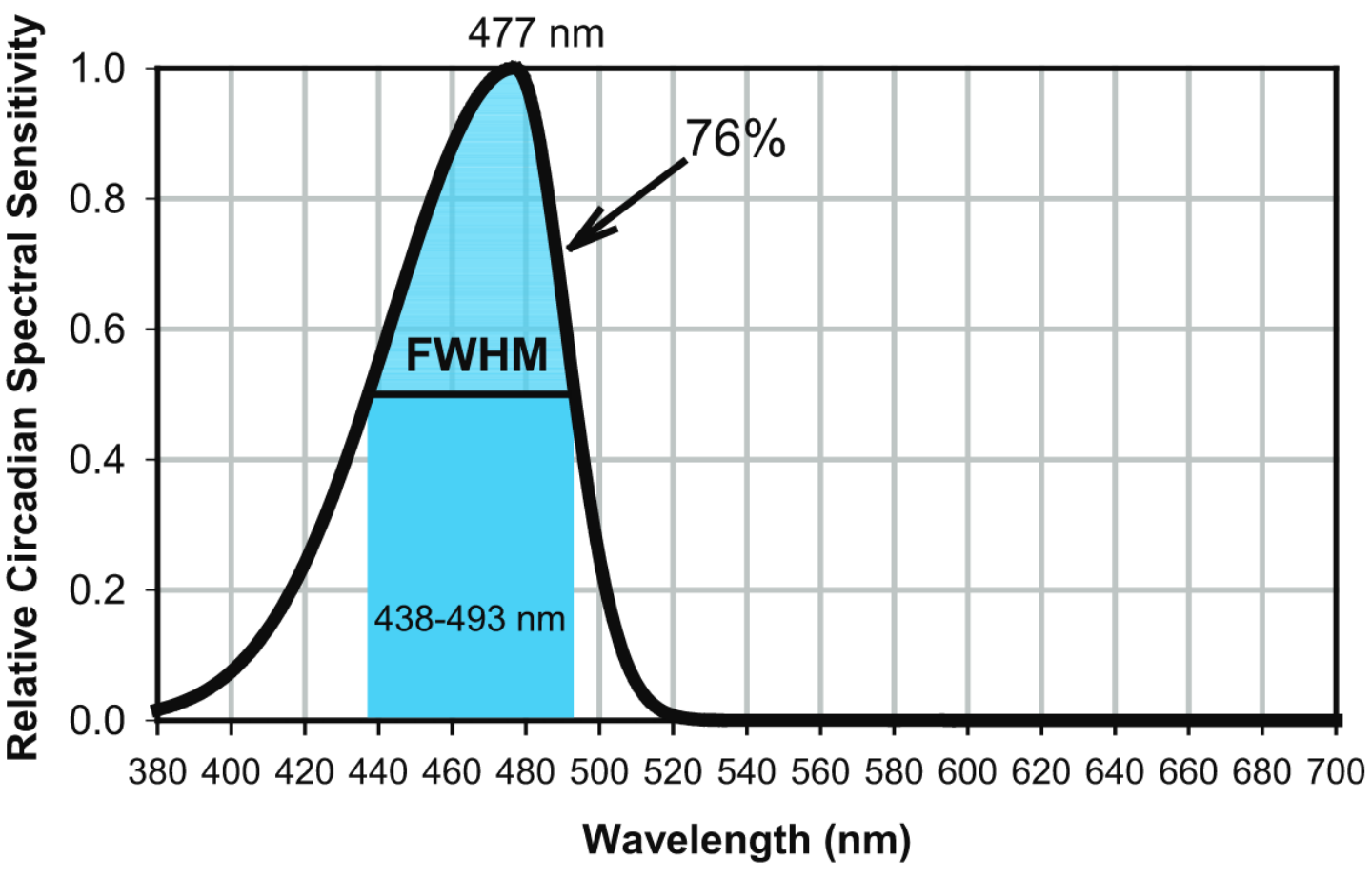
Blue Light and Human Sleep
Study after study reaches the same general conclusions: Blue light, in the ~450-480nm range, suppresses melatonin production and, if used in the evenings, starts to mess with human sleep in important ways. A study that hit particularly close to home for me, being a fan of my Kobo, looked very specifically at the sleep results of people reading with an e-reader (LED backlight) in the evening, versus reading paper books. “Evening use of light-emitting eReaders negatively affects sleep, circadian timing, and next-morning alertness” is a study looking very specifically at “reading on an ereader” vs “reading a book” in the evening. We’ve all seen the “Blue light from screens is bad for your sleep!” articles, and a very reasonable question many people have is, “Is it the light, or is it the mental activity from the screen?” This study attempts to answer it by having participant in a 14-day inpatient study (!) do the same thing in two different ways: Read a book before bed.
They measured the spectrum from the e-reader, which, again, has a peak in the blues. You can compare this to the chart right above and notice a significant overlap…

The results were quite clear, and I’ll quote their “Significance” result in full here:
The use of light-emitting electronic devices for reading, communication, and entertainment has greatly increased recently. We found that the use of these devices before bedtime prolongs the time it takes to fall asleep, delays the circadian clock, suppresses levels of the sleep-promoting hormone melatonin, reduces the amount and delays the timing of REM sleep, and reduces alertness the following morning. Use of light-emitting devices immediately before bedtime also increases alertness at that time, which may lead users to delay bedtime at home. Overall, we found that the use of portable light-emitting devices immediately before bedtime has biological effects that may perpetuate sleep deficiency and disrupt circadian rhythms, both of which can have adverse impacts on performance, health, and safety.
Another study looking into the impact of blue on sleep (but focusing more on overnight room lighting) found similar results. “Acute exposure to evening blue-enriched light impacts on human sleep” performed similar tests on human sleep in a range of lighting conditions with the following results:
Our data suggest that exposure to blue-enriched polychromatic light at relatively low room light levels impacts upon homeostatic sleep regulation, as indexed by reduction in frontal slow wave activity during the first non rapid eye movement episode.
The results go on, if you care to look. Blue light, in the evening or at night, is bad for human sleep. Screwing with human sleep and melatonin levels, meanwhile, is linked with a whole range of other unfriendly outcomes…
Melatonin and Cancer
The link between lower melatonin levels and cancer has been percolating around medical circles for a while now. A meta-study from 2004 “Minireview Melatonin and cancer risk: does light at night compromise physiologic cancer protection by lowering serum melatonin levels?” looks at the link between night light and cancer:
Observational studies support an association between night work and cancer risk. We hypothesise that the potential primary culprit for this observed association is the lack of melatonin, a cancer-protective agent whose production is severely diminished in people exposed to light at night.
I’ve snipped the study citations and some details for readability here, though they’re available in the original if you want to run them down yourself:
Observational studies have supported that theory, indicating that women in occupations that expose them to light at night do experience a higher risk of breast cancer, and that blind women, who do not have the ability to experience lower melatonin levels because of their supposed lack of receptivity to light, have a lower incidence of breast cancer. Studies fairly consistently report meaningful increases in breast cancer risk among postmenopausal women exposed to shift work. Two retrospective studies of flight attendants with occupational exposure to light at night linked the employment time to an increased risk of breast cancer. Two nationwide record linkage studies and a retrospective case – control study associated night work with an approximately 50% higher risk of breast cancer. Finally, the Nurses’ Health Study, the only prospective study published that evaluated the association, observed a positive association of extended periods of rotating night work and breast cancer risk. … A positive association between the number of years a woman had worked on rotating night shifts and breast cancer risk was observed (test for trend, P ¼ 0.02). Among postmenopausal women, the relative risk for breast cancer, controlling for all the major risk factors for breast cancer, was moderately increased after 1 – 14 and 15 – 29 years of rotating night shift work, and was further increased (RR 1.36; 95% CI 1.04 – 1.78) for those nurses who worked the night shift for 30 or more years, with similar risks for premenopausal women (RR 1.34; 95% CI 0.77 – 2.33). Thus, in sum, observational studies seem to support the hypothesis that night work increases the risk for breast cancer. This association may be mediated, at least in part, by the oestrogen pathway.
The reference to blind women lacking sensitivity to light is actually wrong here - most blind people do have a sensitivity to blue light, through the ipRGC cells. What they don’t do is use indoor lighting, because it’s utterly pointless to them - so their bodies are on purely natural light cycles. There are other studies that look at circadian sync with blind people that came to the baffling (before ipRGCs were discovered) result that, yes, they do sync to blue.
“Melatonin, sleep disturbance and cancer risk” gets to the point as well:
The pineal hormone melatonin is involved in the circadian regulation and facilitation of sleep, the inhibition of cancer development and growth, and the enhancement of immune function. Individuals, such as night shift workers, who are exposed to light at night on a regular basis experience biological rhythm (i.e., circadian) disruption including circadian phase shifts, nocturnal melatonin suppression, and sleep disturbances. Additionally, these individuals are not only immune suppressed, but they are also at an increased risk of developing a number of different types of cancer.
Even before LED lighting really took off, the impact of “light at night” and “certain cancers” had been identified. “Light at Night Co‐distributes with Incident Breast but not Lung Cancer in the Female Population of Israel” looks at breast cancer vs regional light at night (LAN), and the abstract concludes:
Nighttime satellite images were used to estimate LAN levels in 147 communities in Israel. Multiple regression analysis was performed to investigate the association between LAN and breast cancer incidence rates and, as a test of the specificity of our method, lung cancer incidence rates in women across localities under the prediction of a link with breast cancer but not lung cancer. After adjusting for several variables available on a population level, such as ethnic makeup, birth rate, population density, and local income level, a strong positive association between LAN intensity and breast cancer rate was revealed (p<0.05), and this association strengthened (p<0.01) when only statistically significant factors were filtered out by stepwise regression analysis. Concurrently, no association was found between LAN intensity and lung cancer rate. These results provide coherence of the previously reported case‐control and cohort studies with the co‐distribution of LAN and breast cancer on a population basis. The analysis yielded an estimated 73% higher breast cancer incidence in the highest LAN exposed communities compared to the lowest LAN exposed communities.
Another study, “Nighttime light level co-distributes with breast cancer incidence worldwide”, finds similar results:
We found a significant positive association between population LAN level and incidence rates of breast cancer. There was no such an association between LAN level and colorectal, larynx, liver, and lung cancers. A sensitivity test, holding other variables at their average values, yielded a 30–50% higher risk of breast cancer in the highest LAN exposed countries compared to the lowest LAN exposed countries.
And the work is ongoing, but it’s pretty clear that “messing with human melatonin and sleep” very much is correlated with at least some cancers. Colon cancer also seems to be related to melatonin suppression.
You know what’s really funny about all this? I knew about the links between light and cancer 15 years ago - I just never applied it to humans. I’ve had ferrets for coming up on two decades now, and they’re quite sensitive to light cycles and light schedules, such that I try very hard to ensure they get natural lighting - because if they don’t, they end up with coats out of season (nothing is quite so miserable as a ferret with a winter coat in summer and a summer coat in winter), and it seems to be correlated to cancers in them as well. A naturally lit ferret is a healthy ferret. Draco tongue!

Spectrums: Incandescent, White LEDs, and Screens
I hope, by this point, I’ve convinced you of the following:
- Humans are sensitive to blue light in the ~450-480nm range for melatonin suppression.
- Melatonin suppression in the evenings is correlated with less sleep, of worse quality (which is quite bad for humans).
- Melatonin suppression is also correlated with increased risks of certain cancers.
So… what have we been lighting our homes with?
Up until fairly recently, we’ve used incandescent lights. I happen to have a few of those laying around (I’d actually been using one for some evening light since long before I started down this particular rabbit trail because they dim far better), and a standard house incandescent bulb’s spectrum looks, to my spectrometer, more or less like this. There’s some blue going on, which is certainly consistent with the pre-LED-lighting results of evening light messing with people, but most of the energy is up past the 480nm range.

Dimmed, the total light output is less, and it’s a bit more red-shifted, but it’s the same general shape. This is a “pure” incandescent lighting curve (at least as seen through my spectrometer - it’s focused on the 400-580nm range and drops off substantially in the reds), and one can reasonably expect to see it on all varieties of incandescent light sources. My Blizzard, a cold blast kerosene lantern, shows almost the same shape:

How about our LEDs? I have some of the Phillips Warm Glow LEDs in my kitchen, which are marketed as warm indoor LEDs that redshift as you dim them (which they do, though they’re certainly not meeting my lifetime expectations as I’ve had to replace several of them already). In their “full bright” mode, their spectrum looks like this - notice the substantial spike in blue compared to the incandescent sources.
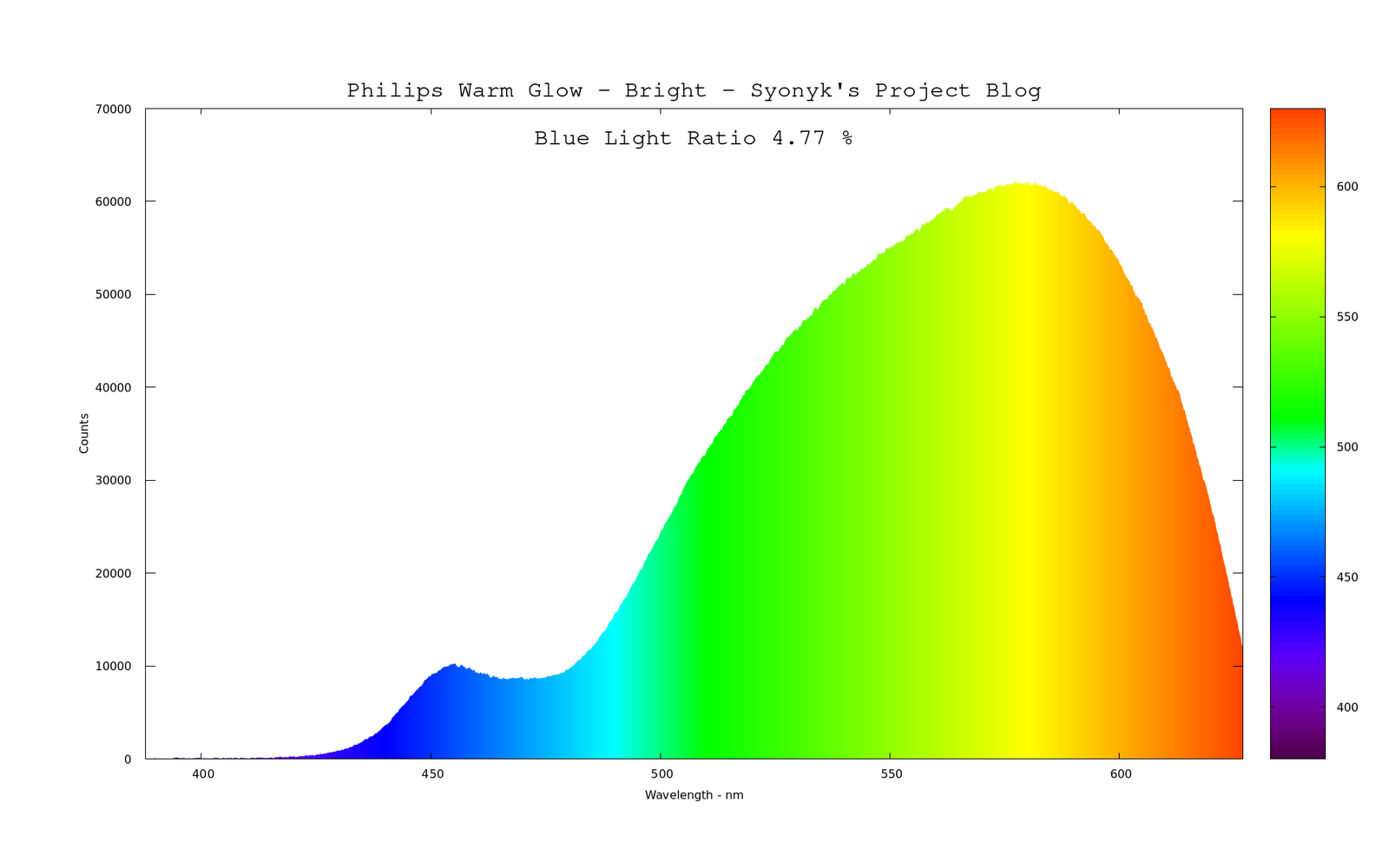
Dim them fully, and they certainly look redder - but there’s still a pretty decent spike in the blue compared to what an incandescent bulb puts out. You can see, even with my meter tapering off in the reds, that the peak is shifted further to the right, and the green curve isn’t as “fat” through the middle. Again, they do what they say, visually, but they’re still a LED light source and still have that blue peak.

I have some 2700K overhead bulbs in the house that put out a similar spectrum. There’s not a huge amount of blue, but there’s still quite a bit, and these are the “warm” color temperature bulbs, with a yellow-ish glass enclosure over them that should help cut some more of the blue.
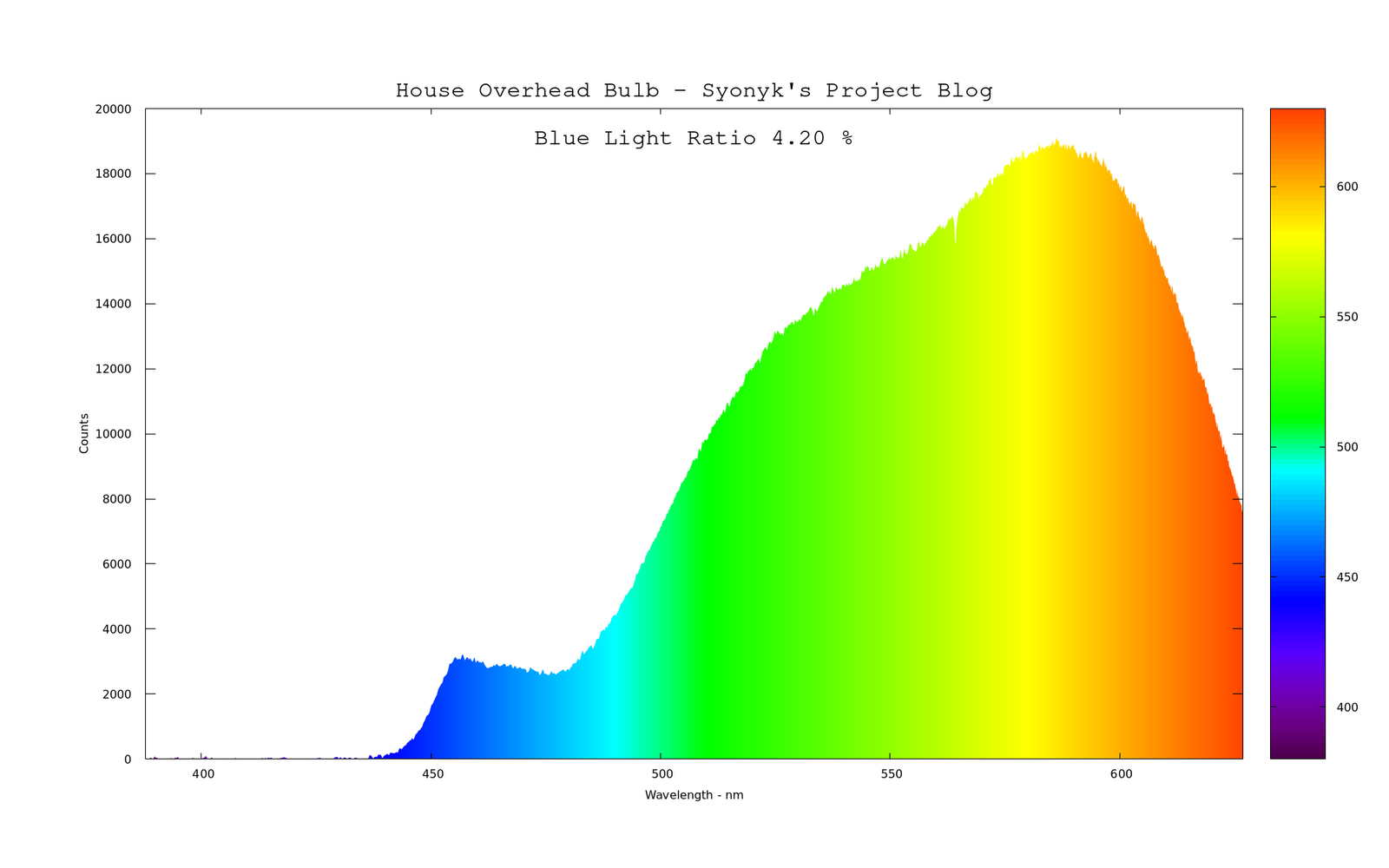
In the kitchen, and some other places in the house, I installed “cool white” bulbs for better color rendering. How are these? Well, these particular bulbs simply shouldn’t be on after the sun goes down! They’re absolutely vile, with a blue peak overlapping with the human visual sensitivity to blue light! If there’s a question about LEDs screwing with sleep, this should strike fear into your heart - these bulbs will keep you up, no questions! I’ve been trying to be far more aggressive about not using them at night.

How about devices? My Kobo Aura, an older e-ink reader, is… well, pretty bad, actually. It’s dim, but also close to my face. I’ve stopped using the backlight at night, and have moved to reading via reflected light from one of several incandescent light sources.
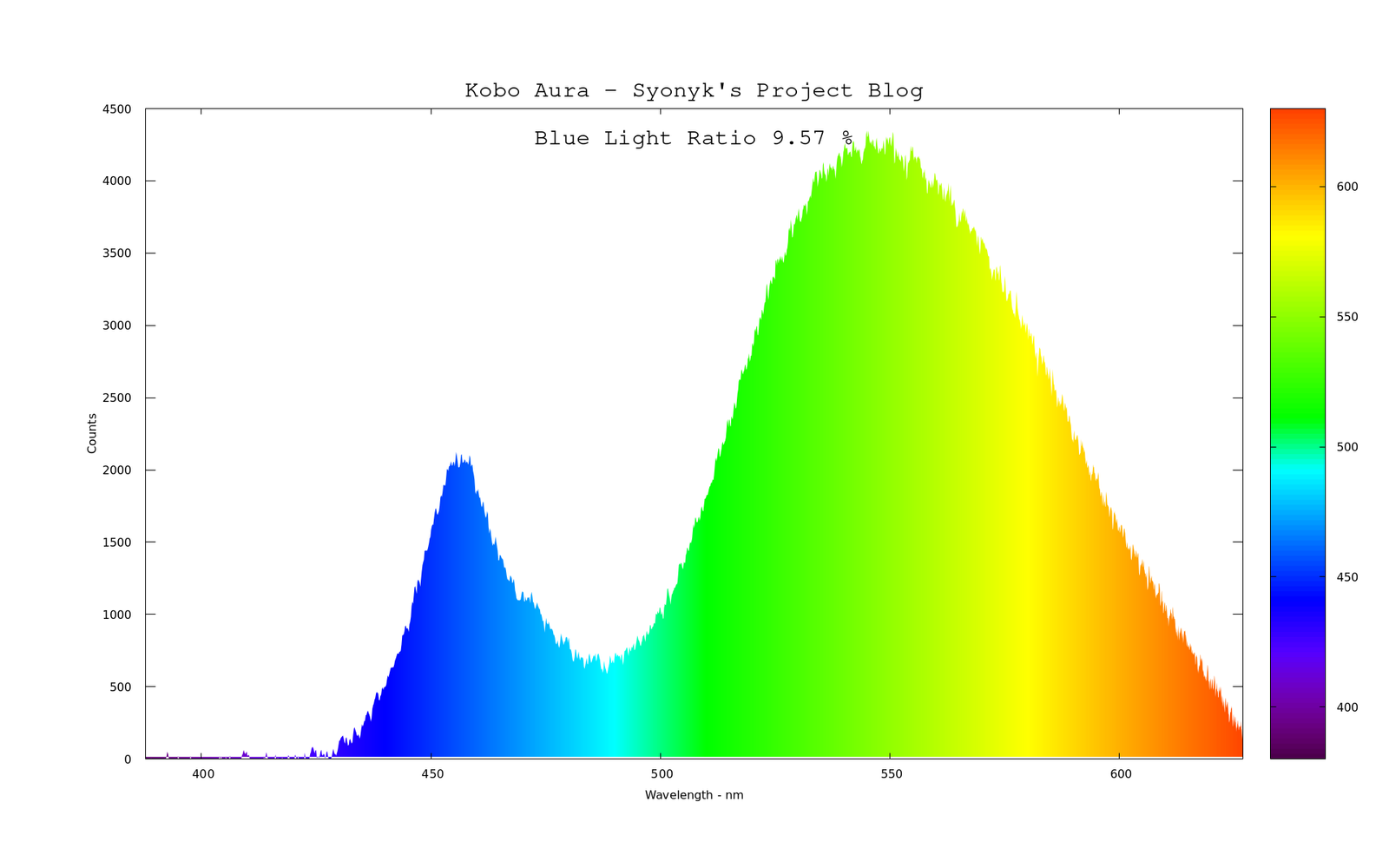
Device Nightshift Modes
There is some good news, though. Most modern devices come with a “night” mode - they red shift the display, and claim to remove a lot of the blue from the spectrum. From what I’ve seen, these actually do what they claim… but I’m also not convinced it’s enough, given the range we view these devices at. I’ll start with my wife’s Kobo Clara HD. It has the “ComfortLight Pro” settings to warm the light for night reading. In cool mode, it’s actually worse than my Aura.
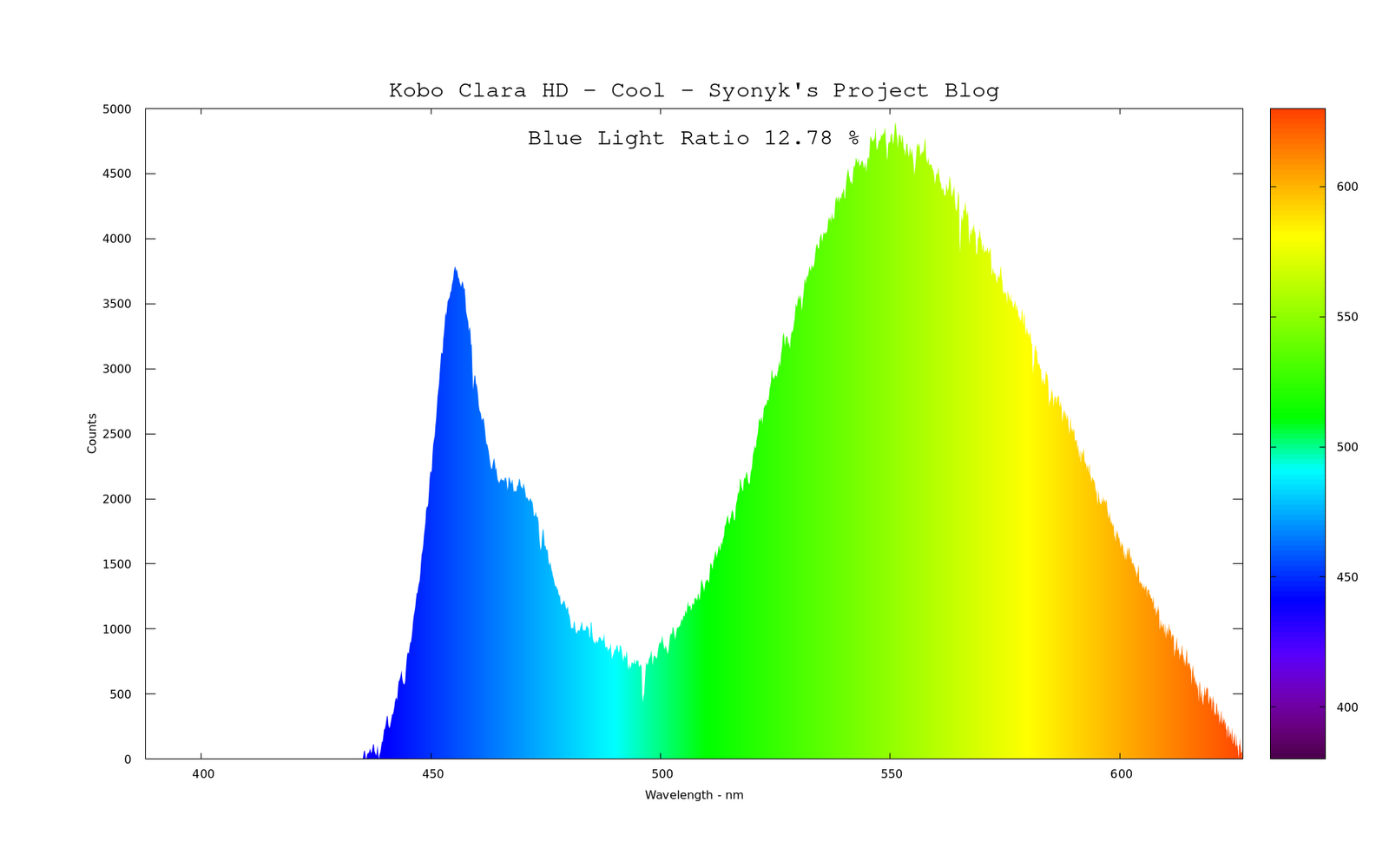
But with the light set to “full warm,” a lot of the blue goes away. It doesn’t all go away, but it really does seem to do what it says on the tin. Is it enough? That’s something you’ll have to experiment with for yourself. There’s still a good bit of blue, and it’s fairly close to your face.

How about an iPhone? Pointing my spectrometer at an iPhone 2020 SE, I get the following (rather interesting over in the reds…) spectrum for normal day mode rendering of a white section of screen.
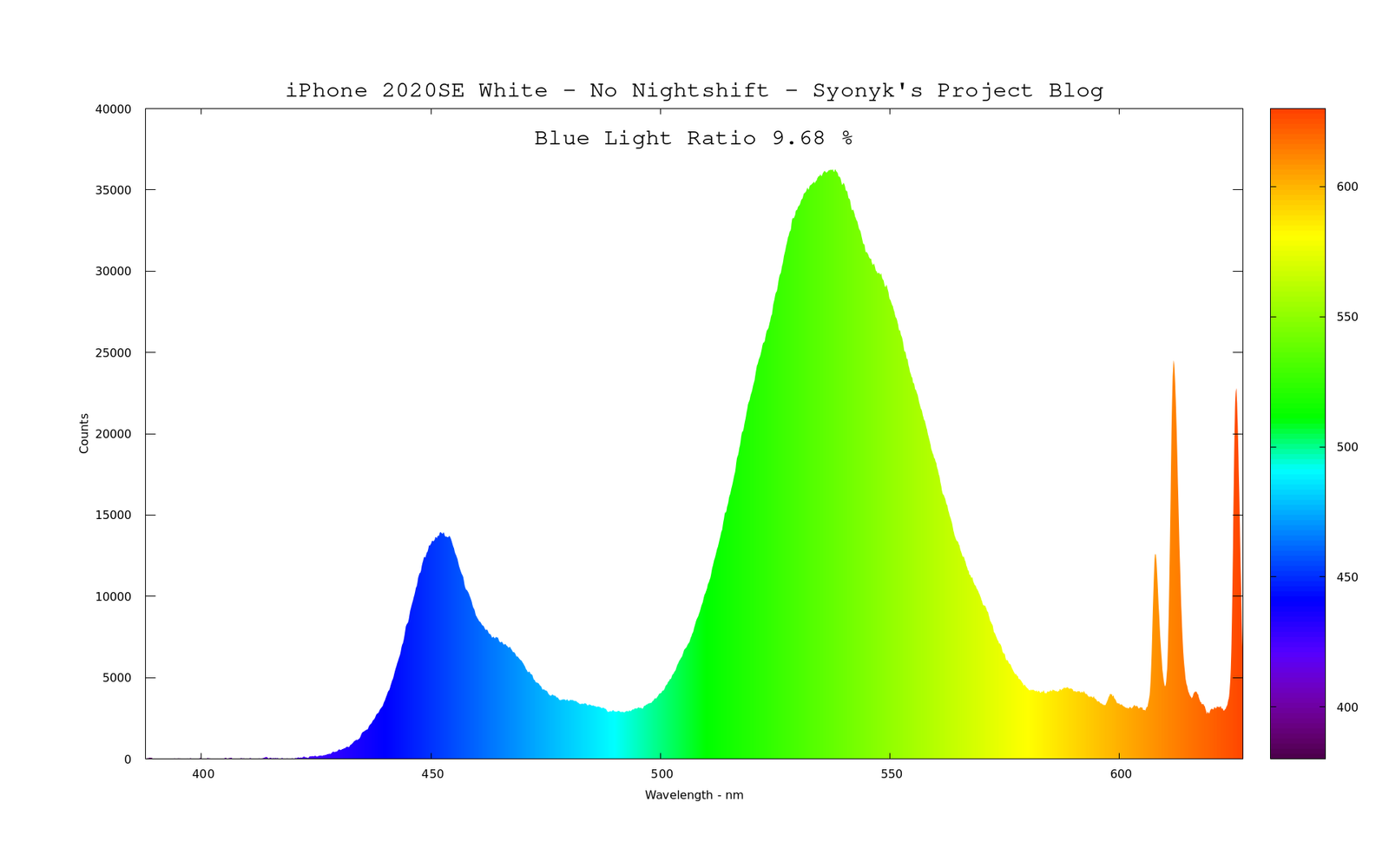
With the nightshift turned up to max, the same white pixels look like this. It’s better, by far - it really does manage to cut out a lot of the blue. But there’s still that spike that’s just substantially overlayed with the human visual sensitivity to blue light, and the phone is typically right up on your face.

Are these redshifted screens OK? That’s going to be something you’re going to want to try yourself, but in my evening experiments, I have to say “I don’t think it’s enough.” I still take a lot longer to fall asleep if I’ve had a self-lit fully night shifted screen in front of my face for the evening than if I’ve been reading a book by the reflection of an incandescent light or a lantern. There’s probably some research to be done here, but… you should really do the experiments yourself with your evenings and see.
Outdoor Lighting
While I’m here, grumbling about modern lighting, turn off your outdoor lights. Seriously. Put them on motion sensors if you absolutely must, but don’t just leave lights burning outdoors all night. The study above, linking outdoor light pollution to breast cancer, has been repeated multiple places with the same results. Outdoor light is really bad for humans. It’s also really bad for animals. The International Dark Sky Association has some things to say, but the reality is that we don’t even know the damage it’s doing, because we don’t understand all that animals use the night sky for.
Did you know that dung beetles use the Milky Way to navigate? What happens when they can’t make out the stars?
How bad is the problem? It’s hard to say, but as LEDs allow more light for the same energy, we seem to be running down the standard paths of the Jevons Paradox, and just adding more lighting. To quote the abstract from “First Estimation of Global Trends in Nocturnal Power Emissions Reveals Acceleration of Light Pollution”:
The global spread of artificial light is eroding the natural night-time environment. The estimation of the pattern and rate of growth of light pollution on multi-decadal scales has nonetheless proven challenging. Here we show that the power of global satellite observable light emissions increased from 1992 to 2017 by at least 49%. We estimate the hidden impact of the transition to solid-state light- emitting diode (LED) technology, which increases emissions at visible wavelengths undetectable to existing satellite sensors, suggesting that the true increase in radiance in the visible spectrum may be as high as globally 270% and 400% on specific regions. These dynamics vary by region, but there is limited evidence that advances in lighting technology have led to decreased emissions.
Seriously. Turn off your outdoor lights at night. And if you’re a city, also turn them off. They don’t impact crime or traffic collisions. They just waste energy. But we have a lot of people today who, based on what I can see of their behaviors with lighting, are simply afraid of the dark. I can’t come up with any other explanation for literally hundreds of watts of LED lighting, lighting the entire outside of a house, when nobody is outside at night.
Day Lighting
How about during the day? Is the blue a problem then?
Nope! If anything, it seems that we don’t get enough blue light during the day - because we’re always inside. So having lights during the day with a strong blue peak actually help set the “daytime” part of the circadian cycle more accurately. Of course, it might be better to just figure out ways to route more sunlight to our workspaces. But those peaky blue 5000K (or higher!) lights simply aren’t a problem during the day (at least in terms of your body cycles). Their color rendering may be poor, but they’re not going to do anything nasty to your sleep if they’re very blue during daylight hours. Blue during the day is a good idea. Waking up and having some bright “cool white” LEDs with a peaky blue spectrum will help get your body going. Just don’t use those lights to go to bed.
How Then Should We Light?
Given all this, what does it actually mean for humans? How should we light? Does it even matter? I’ll argue that it absolutely does matter, and I’ve made a number of concrete changes in how I handle my day/night cycles, light, evenings, etc. The answer simply seems to be, “Follow the sun.” If the sun is in the sky (even if you can’t see it), blue light from LEDs doesn’t matter, and it’s probably helpful. Think of the bright “happy lamps” that so many places have in Seattle - they’re a blue enriched spectrum. But when the sun goes down, whatever lighting sources you’re using need to follow the trend and cut out the blue as well. In the winter especially, this is going to imply a pretty early “lights down” time for most people. Winter is not a time to be staying up late, staring at bright blue screens under bright blue LED lights until the late hours, then staying up half the night wondering why you can’t get to sleep.
I have talked to so many people in the last six months or so who have trouble getting to sleep, and recognize that the problem started 5-10 years back - often around the time they switched to LED lighting, or got more LED lit devices they use in the evenings. If you’re taking hours to fall asleep, hear me out, and try the experiment yourself!
I know some people (tech workers!) who have a simple policy of “No screens after sunset.” It doesn’t matter if they’re redshifted, distant, etc… that’s just their policy. It’s simple, and it works. I’ve tried it. I usually end up in bed earlier than usual for me, asleep far faster than usual. This is good.
But I don’t think that’s quite needed. The effects are related to not just the frequencies of light involved, but also the intensities - and the inverse square law is helpful here. Light intensity drops with the square of distance. As you double the distance from a light source, the light intensity drops off by a factor of four. If you do the math on a smartphone in front of your face and a TV set to “night dim” across the room, the intensities are radically different. Don’t leave the TV running all night, but neither can I convince myself that a TV across the room is nearly as bad as a screen in front of your face in terms of blue emissions. Just run it as dimly as you can. I’ve done the math with our TV - the difference, in the night settings I use, is 28W delta between “black screen” and “standard full screen media content.” I view from 15’ away. I typically look at a phone or iPad from about 1’ away. Inverse square says, “1/225th the energy.” So for the same impact, my phone screen has to be less than 124mW - and I’m pretty sure it’s several times that, even set fairly dim.

The real sticking point, though, is lighting. Our eyes are much more sensitive to blue coming from above than from below - the sky being up there and all. Most rooms are lit from above. So even mildly blue emitting LEDs overhead are going to convince our bodies that it’s daytime, and we ought to stay awake. That’s the core of the problem.
I’ve solved it by going back to dimmed incandescent light sources for lighting at night. I’ve replaced overhead LED bulbs with incandescent bulbs on dimmers in the sections of the house we use at night, and I typically run them pulled way back after dark - 30% or so on the dimmer. Your eyes have an amazing dynamic range, from handling noontime sun down to literally detecting a single photon. The paper “Direct detection of a single photon by humans”, in the abstract, states: “Here we report that humans can detect a single-photon incident on the cornea with a probability significantly above chance.” Your eyes are amazing. Let them work. You don’t need full lighting power at night, so use a dimmer, pull the lights way back (which even further reduces the blue from incandescents), and let your eyes adjust. It doesn’t use much power, and it’s better for your body. What’s not to like?
… or use this as an excuse to buy some beautiful lanterns. I certainly have. I spend many evenings now curled up with paper books by lantern light, and it’s wonderful in so many ways.
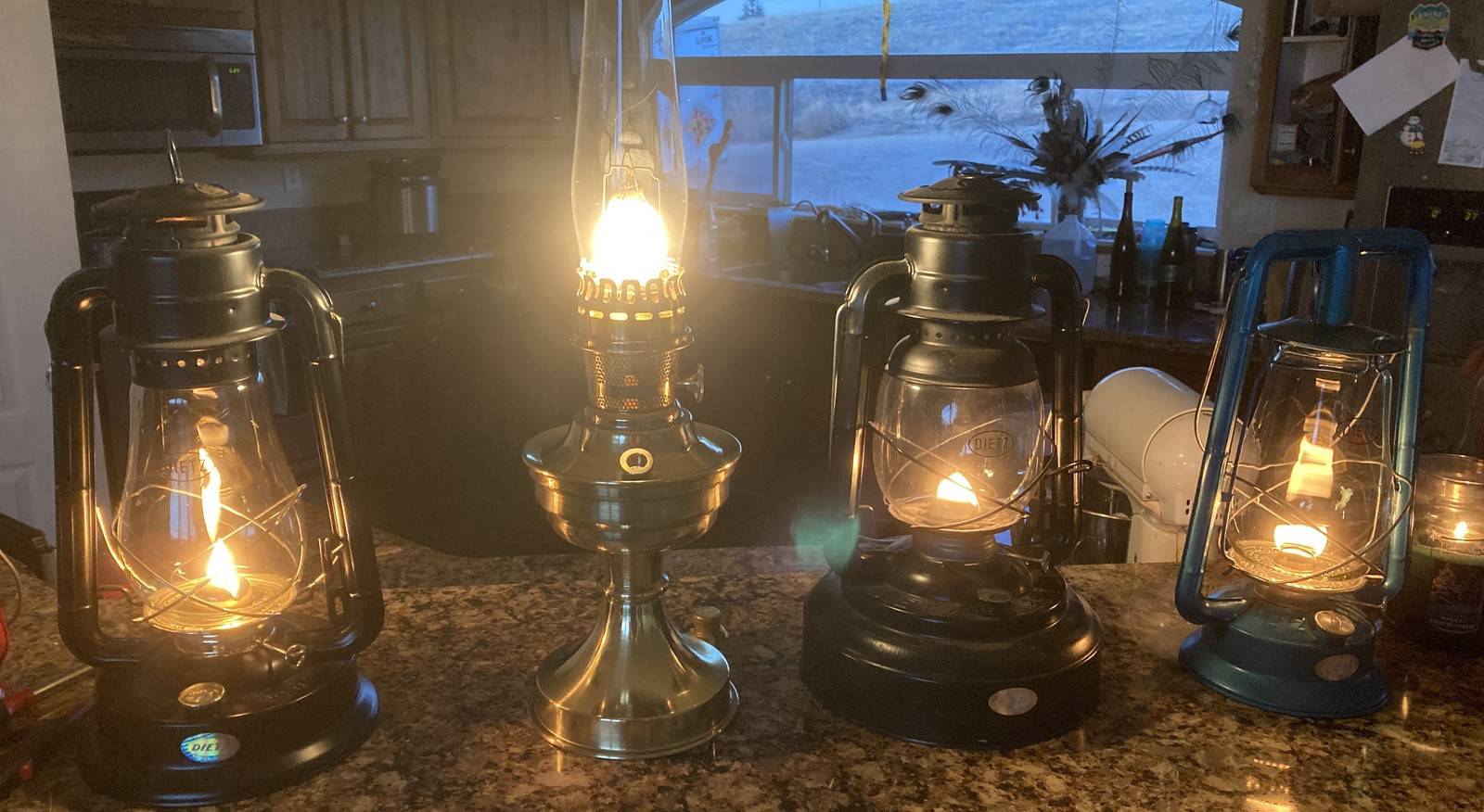
Efficiency of Lighting
At this point, I expect at least a few people will decide I’m in the pocket of Big Energy or something, out to argue with the obvious energy efficiency benefits of LED lighting and demanding people “go backwards” to incandescent lights that “aren’t as efficient.” If I am, the checks are certainly lost in the mail.
LEDs are more efficient than incandescent bulbs - in terms of lumens of light output per input watt of electrical energy. No question. I’m not arguing that in the slightest. But that’s not the right question to be asking. Not from a human-centered perspective.
A better question to ask would be something like “How can we use the least energy to usefully light indoor spaces after dark, in ways that don’t inhibit our natural circadian cycles nor pose a great cost to our health?” It’s not a question that’s had to be asked until very recently, because the history of human lighting sources haven’t allowed for the levels of light, and especially the blue light, where it mattered. But neither do we seem to be asking it now. Except I am.
I argue that our current, “off the shelf hardware store” LEDs simply can’t meet the requirements of that question (they do screw with our circadian rhythms at some very real cost to our health), so their luminous efficiency is irrelevant after dark. It’s not the right thing to be looking at. It’s like talking about how you’re doing 80mph, so you’re obviously making great time - when you’re on the wrong highway going the wrong direction.
Regardless of what you put in your sockets, though, buy dimmers. They are wonderful things, and the modern ones can usually handle something like 600W of incandescent lights or 150W of LEDs (real power draw, not “looks like a XX watt bulb”). And, yes, the lumenous efficiency of incandescents does drop at lower power settings, but in terms of absolute power, a dimmed set really isn’t drawing that much power.
And stop using so much light at night! To quote your parents, “Turn the lights off!”
Light Longevity
Along the same lines of “But the Efficiency!” complaints, I also expect to see the standard complaints about how LEDs last 25,000 hours, and incandescents only last 1000, because of the Phoebus Cartel! That group was, in fact, dissolved in 1939, and there are plenty of long life incandescents out right now, should you care to find them. They’re just less efficient, in terms of lumens out for watts in - this is the tradeoff one makes. This 75W, 20k hour life bulb, puts out about the same light as an older style (bare filament) 60W bulb (not the new “high efficiency” halogen ones, though).
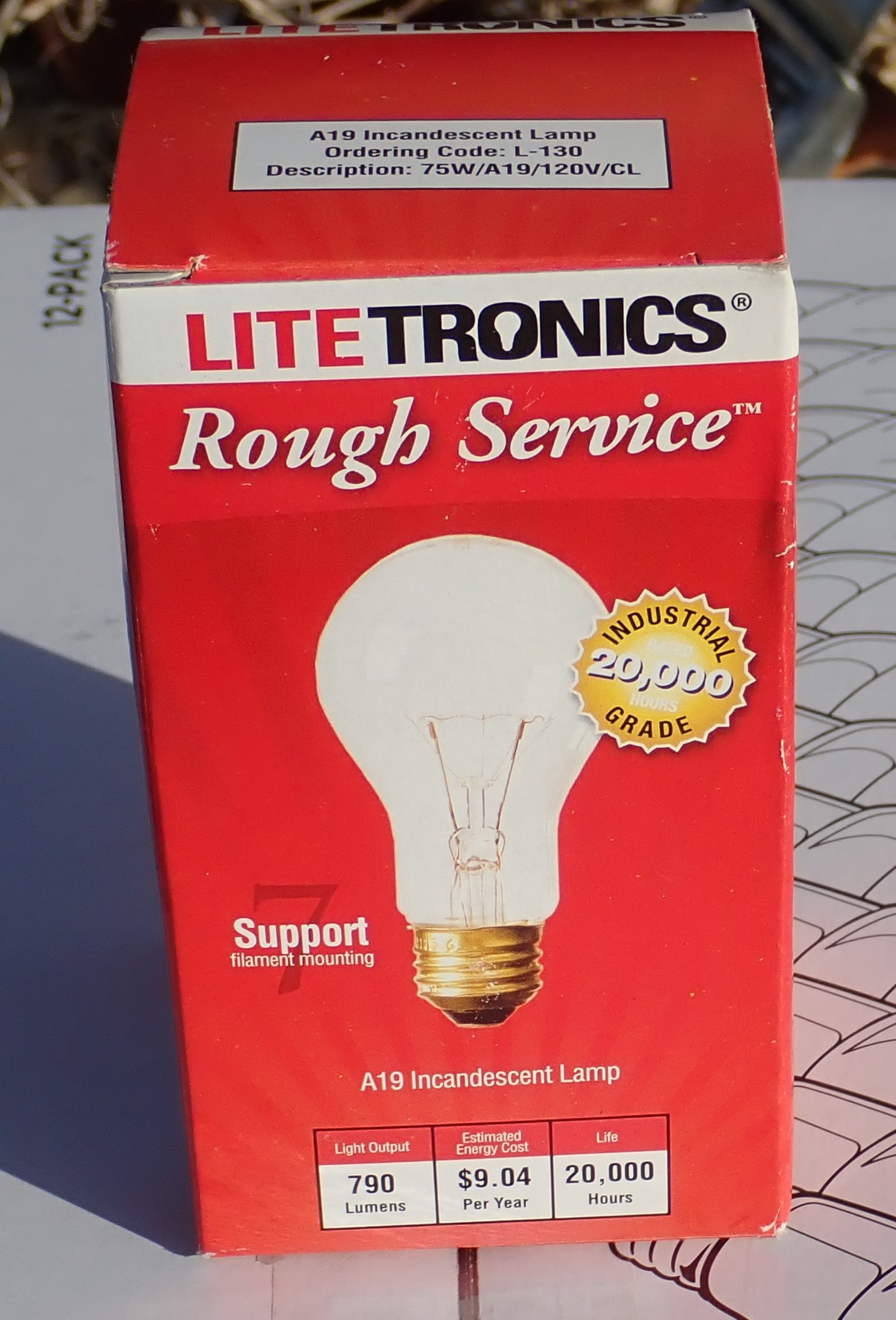
But, more than just that, dimmers make incandescents last nearly forever. Yes, they may be rated at 1000 hours of operation at full voltage, but if you look at the Lamp Rerating page on Wikipedia, you’ll see something insane in the exponents.
Rerated life = (Va/Vd)^−12 to -16 × Life at design voltage
Yes, -12 to -16! This means that dropping the bulb a few volts makes a huge difference in bulb life! The main incandescent bulb page goes into more details, but the point is that if you’re dropping the effective voltage applied to the bulb, running the filament cooler, they last a very, very long time. Lumenous efficiency will drop, but if you’ve been following along so far, you don’t need that much light at night. Drop the bulbs way back, and even though the efficiency is lower, so is the absolute power they’re pulling, while also not dazzling you with blue.
Really, though. 25k hours? Maybe if you never turn them off, but I’ve had to replace an awful lot of the “long life LEDs” in the 7 or so years I’ve been in our current house. They die, they flicker, they flash, and the “Phillips Warm Glow” sort I’d been using in various places in a misguided attempt to do something reasonable in the evenings are even worse about it. Whatever the claims made, the actual reality is different, and I know you’ve seen the same things.
Experiments to Try
The first time I heard about this sort of thing, I honestly thought it was a load of rubbish - of course our LED lights, being promoted by everyone, would be safe for humans. Our politicians wouldn’t be mandating something that were horrible to human sleep patterns, would they? The LEDs use less power for the same light, they don’t have the “Oh, whoopsie, mercury spill hazmat!” problem of broken CFLs, they last basically forever… this is just some random conspiracy theory!
And then I dug into it, and realized that… well, actually, this really is a problem. There’s a lot of data to back it being a problem in terms of studies that all end up with the same results. And I experimented with my evenings, and realized that I could tell the difference in when I got tired and how quickly I fell asleep. And so I collected more data, read more papers, and have written this post you’re hopefully still reading along with.
So, I encourage you to experiment with it. If you have any section of your house you can easily put a dimmer and a few incandescent bulbs in, do so. The incandescents are already getting harder to find (the Biden administration has gone about actually getting around to banning the general service ones), so your time window on this is somewhat limited, but if there’s a circuit with one or two fixtures on it, hook up a dimmer. Put the incandescents in (you might consider stocking up on what you can find - eBay will help you here). And try running with them in the evening, while not staring at LED lit screens. Yes, I know the night modes claim to help, and I’m arguing that, up close to your face, they’re not doing enough. Your eyes are really sensitive to blue over time, and an evening spent on a screen with night mode enabled just isn’t the same as not having the device in front of you. I’ve tried it. I notice the difference.

Then pay attention to when you get tired, and how you sleep. Log it if you want. Our circadian rhythms are reset daily, so “blue light yesterday evening” won’t affect you (much) tonight. The days are getting longer, but take a week and experiment. See what you find out.
Future Reviews
Now, don’t get me wrong here: I’m not opposed to LEDs as a technology. I’m simply opposed to the amount of blue light that our currently available white LEDs are pumping out. There are some “low blue” LED bulbs out there, and there are the various color shifting bulbs that seem like they should be able to help reduce the amount of blue in the evenings (I hate “smart bulbs” as a general concept, but I’m willing to experiment on a few to see how they actually work). So I’m going to experiment and see if I can find anything that’s both low in the blue, and dims properly (red shifting, removing the blue, dropping down to a very low brightness level). There’s also been some interesting work with “violet pumped” LEDs that have emitters outside the blue range that messes with humans, towards the UV.
And I’m also going to be doing some more in depth analysis with incandescents of a range of technologies, because they’re not nearly so boring as you might believe!
Final Thoughts
This has been another one of those “Oh, this is a topic worth looking at briefly!” sort of posts that has simply grown, and grown. I’ve been working on this one for most of the winter - from some initial playing around with papercraft spectrometers, to buying a spectrometer, to evenings spent chewing through dozens of research papers that looked interesting to find the most relevant, to experimenting on myself in the evenings with “How I light” versus “How I sleep.” I’ve had evenings in front of redshifted screens where I toss and turn for hours (for years, this has been normal and I’ve just assumed “I’m slow to get to sleep”). But I’ve had plenty of other nights this winter where I’m very careful with lighting, and I’m asleep almost as soon as my head hits the pillow (which, again, has been very rare for me - most of my evening activities have involved LED lighting in some form or another). I’ve had evenings spent in light so deeply red that a brief glare of a 5000K LED, which I’d normally describe as “white,” comes across as “eye-searingly blue.”
And the results are clear. The studies are clear. My personal experimentation is clear. If you care about your health, you should care about your sleep, and about your overnight melatonin levels. And if you care about those, you have to be very, very careful about any sort of LED lighting once the sun has gone down. Screens and LED lighting both have the same impact. There’s simply no way around it. If you dislike the obvious conclusions about how this needs to apply in your life, well, I wasn’t happy about it either - but neither can I deny that it makes a very real difference.
Please. Try it. See how it works. And report back!
Comments
Comments are handled on my Discourse forum - you'll need to create an account there to post comments.If you've found this post useful, insightful, or informative, why not support me on Ko-fi? And if you'd like to be notified of new posts (I post every two weeks), you can follow my blog via email! Of course, if you like RSS, I support that too.
